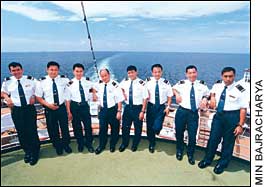 It's a good thing that the laws of economics don't always work. If they did, the Nepali economy would have crumbled after the disastrous 2001/02 fiscal year. All major economic activities-tourism, manufacturing, investments and exports-reported major downslides and even agricultural production and imports slackened. Revenue barely covered government spending, and collection has almost come to a trickle. "These are signs of an economy that is becoming bankrupt," says Raghav Dhoj Pant, former vice chairman of the National Planning Commission.
It's a good thing that the laws of economics don't always work. If they did, the Nepali economy would have crumbled after the disastrous 2001/02 fiscal year. All major economic activities-tourism, manufacturing, investments and exports-reported major downslides and even agricultural production and imports slackened. Revenue barely covered government spending, and collection has almost come to a trickle. "These are signs of an economy that is becoming bankrupt," says Raghav Dhoj Pant, former vice chairman of the National Planning Commission. But not everyone agrees with Pant, especially people in the urban areas, where consumption patterns have not changed and where real estate transactions, in particular, have continued to rise.

The explanation lies in Nepal's remittance economy. Employment abroad has not only helped lessen the impact of the growing unemployment problem, it also continues to inject much-needed cash into the economy. It has also been propping up foreign exchange reserves, helping the country avoid a major Balance of Payments crisis. Some days ago central bank officials said that they estimated that about Rs 70 billion-almost two-thirds of the budget-was coming in as remittances every year.
The central bank's books do not reflect this, however, as much of this money comes in through informal channels. Officially, in 2001/02 about Rs 16 billion came in through proper banking channels, of which Rs 6.1 billion was sent by Nepalis working in India and another Rs 9.8 billion by workers overseas in third countries. When Nepalis working abroad send money back home through legal channels, they use Western Union and Money Gram, or commercial banks. Those figures are from before the central bank allowed the International Money Exchange to transfer money from workers in Malaysia in May. In its first two months of operations the IME brought in $200,000.
This is what powers the economy:
. Of the Nepalis working abroad, 24 percent are in India, 16.3 percent in Saudi Arabia, 6.88 percent in Qatar, South Korea and the United Kingdom, 5.6 percent in the United Arab Emirates, and 1-5 percent in Japan, Malaysia, Germany and the United States.
. 60 percent of those working abroad are between the ages of 26-40, 20 percent over 41, and 16 percent are below 25.
. Nepalis abroad tend to do the same thing-an overwhelming 85 percent are labourers, 16 percent are in the armed services and two percent are in organised government employment.
. Among those working abroad, 49.4 percent earn about Rs 10,000 per month, 20.6 percent earn Rs 10,000-25,000, 12.8 percent earn Rs 25,000-50,000, 8.1 percent earn between Rs 50,000-75,000 and another 8.1 percent earn over Rs 75,000 each month.
. Twenty-one percent send money home through friends and acquaintances, 19 percent through the banks, 17 percent through money order and seven percent through the hundi (informal channel). The remaining 36 percent said they sent money using either one or more of these facilities depending on the circumstances.


